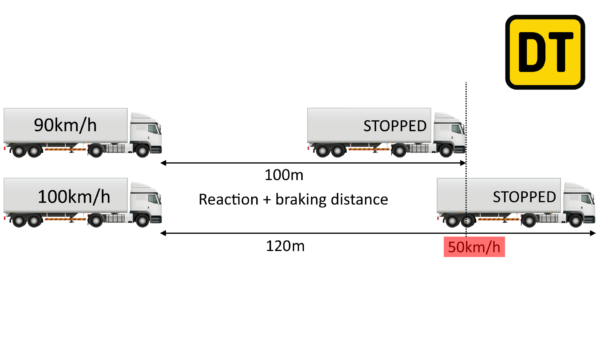Your family car probably weighs around 2000kg all up with you, a passenger and its fuel. It has four wheels in contact with the road – small rubber patches, no bigger than the size of a CD case (remember those?). If you brake from 90km/h, you’ll be stopped in 45m.
What about a massive semitrailer? This could weigh 50,000kg and could have 24 or more wheels touching the road, spread over 9 axles. In this case, each tyre is carrying an average of 2083kg compared to around 500kg per tyre for the car.
Truck tyres are different to car tyres, and there is more rubber in contact with the road, but that doesn’t make up for the raw physics of the fact that the semitrailer is 25 times heavier. More weight on each tyre does improve the the friction of the tyre on the road, but it doesn’t compensate fully as there’s a limit before the wheel will lock and the rubber will simply skid across the road’s surface.
This results in stopping distances that are around 50% further in a truck than a car. While a truck driver may be able to react more quickly to changing scenarios ahead, given that they have a driving position that gives them a better view, the driver is less likely to have anti-lock brakes, autonomous emergency braking or forward collision warning to help.
How does speed affect braking distance in heavy trucks?
The rate of deceleration, or slowing down, is exponential when braking and this is made obvious when you look at a simple change of 10km/h.
When braking. a truck that brakes from 100km/h will still be doing 50km/h when a truck doing 90km/h has already stopped.

How can a truck driver reduce braking distances?
A driver can:
- Use engine braking and retarders to reduce speed. These will begin to slow the vehicle down as soon as the driver releases the accelerator, providing some braking while the driver is moving from the accelerator to the brake, plus it reduces brake fade. Brakes don’t work as efficiently when they are already hot.
- Use scanning and anticipation to react more quickly to developing hazards.
- Keep a safe distance from the vehicle in front to avoid panic braking and locking up the wheels
- Ensure tyres are at the correct pressure
- Ensure tyres have enough tread depth
Reducing the reaction time to developing hazards and maintaining a safe speed are the two biggest factors in avoiding crashes. Awareness of the vehicle’s blind spots also helps.

